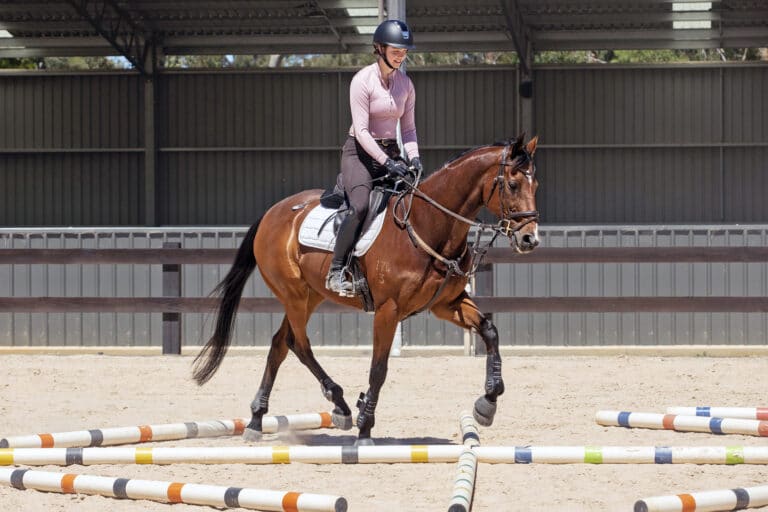Playing with patterns
A registered British Horse Society Instructor, Lucy Williams holds an IGEQ Level 3 Equestrian Coach Passport, is an accredited Level 2 Ride With Your Mind coach, and is passionate about training with poles.
Lucy Williams has trained and worked with many coaches at prestigious equestrian centres throughout the UK. Notably, she coached for Christopher Bartle FBHS (former trainer for the German National Eventing Team and current British Eventing Team coach) at Yorkshire Riding Centre, and for Olympian Jane Bartle-Wilson.
Before moving to Australia, Lucy predominantly evented while dabbling in other disciplines. Now, she’s enjoying training and competing her two young horses in dressage, with a little eventing on the side. Because of the myriad benefits it offers, regular pole work stars in her own training program and in her popular pole pattern clinics.
Why poles?
For her own horses and for participants in her clinics, Lucy’s main objective is to have fun! “It’s interesting to incorporate poles to improve suppleness, balance, joint function, core engagement, dexterity, coordination, adjustability, strengthening of the back and topline,” she says.
So how often should you use poles as part of your training regime? “I am a huge fan of cross training, meaning that even for the pure dressage horse your training isn’t just in the arena. It’s so important to include other things. This helps keep your horse happy and interested in their work and gets them using their whole body,” Lucy explains. “My horses do trail rides, jumping, pole work and hill work, as well as dressage training. To fit everything in, I do pole work or patterns once a week, but might also utilise poles in a couple of other sessions.”
To build the horse’s confidence, Lucy recommends introducing these types of exercises bit by bit. “Most of us don’t have a pole crew and don’t want to get on and off, so I tend to lay out a few smaller exercises that can be mixed up, practicing riding lines from one small pattern to another. For example, riding some arrowheads to check straightness, then to a curved line to check stride length and turnability, then some raised poles for suspension.”

Steph and Golden Delight BHI (Dorothee) canter poles on a curved line.
Rider perks
The horse is not the only one to benefit from pole exercises. “For the rider, it’s about being a well-balanced framework above the horse and allowing them to find their own balance, without holding them together with too much hand and leg,” Lucy explains. “Pole work is absolutely fantastic at showing riders exactly what their issues might be in their dressage training, cross country riding or show jumping. Whether it’s inconsistency of rhythm or tempo, the horse’s inability to adjust stride length within their tempo, loss of straightness, or if they as the rider lose their balance in any direction.” She believes that as riders, we need to be introspective, and be prepared to analyse ourselves and improve.
The best horses in pole pattern sessions have great rhythm, are straight, and are on the rider’s aid, so they’re quick to respond to a ‘go’ cue, a ‘woah’ cue or ‘turn’ cue. “Having a well-balanced rider allows the aids to have clarity and not be confused,” Lucy says. “It’s when these basic foundations aren’t set in place that challenges emerge, like horses rushing, not holding a constant tempo, or lacking straightness.”
Lucy’s experience as a coach has taught her that over analysis really does cause paralysis, with some riders simply overthinking things: “I encourage them to soften their eyes and ride with more peripheral vision. This can be hugely helpful for making them trust the horse and feel change underneath them, whilst tuning into their own body.”
The set up
In a group pole session, Lucy often uses up to 15 poles in a line, incorporating tunnels, arrow heads, and plain straight poles, all of which are added gradually. At home, Lucy suggests you follow her pole teb the average sized horse) of one walk stride equal to 3 feet, one trot stride to 4.5 feet, and a canter stride equalling 9 to12 feet.
To make life easier when she’s riding by herself, Lucy tends to set up nine foot exercises, as they are divisible by 3 and 4.5 feet. “That way you can fit three strides of walk, two strides of trot and one stride of canter in a nine foot distance,” Lucy explains. “Obviously, horses can vary significantly from that pattern, but it’s a good baseline. You might have to make it slightly longer for the bigger horse and shorter for the smaller horse, keeping in mind that within reason, you’re generally needing to encourage the long striding horse to sometimes take shorter steps and vice versa.”
Lucy recommends practicing walking pole distances. “Mark out a three foot distance and get familiar with how big or small you have to stride out to make it. My poles are ten feet long, so I know three even, big strides of mine make a nine foot distance with one foot left at the end.”
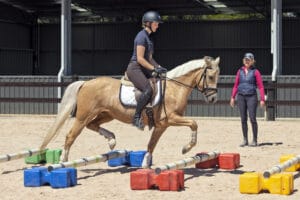
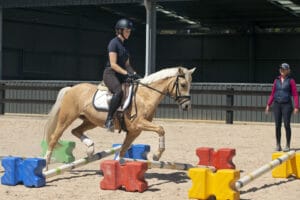
‘Go to’ favourites
One of Lucy’s favourite exercises is poles on a curved line, especially when she doesn’t want to get on and off the horse! “I use this as my regular ‘go to’. I set the midline of each pole on the curve to nine feet, with the inside of the midline at approximately seven feet, and the outside at eleven feet. Then, through a session I can adjust stride length to poles on a curve, on both reins, in all paces.
She says this is an easy, work everything exercise: “Practice turning, shorter steps and longer steps. I always find poles on a curved line help to work the evenness of your bend on both reins, as you very easily feel drift and loss of line. When the horse keeps his body aligned with the line you want to ride over the curve, you will have core engagement and correct back lift.”

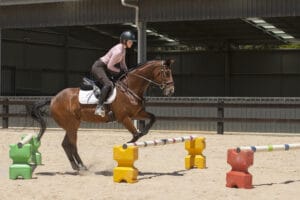
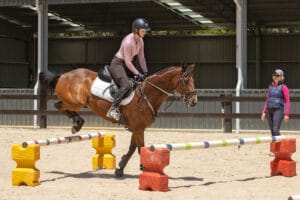
Images top to bottom: A low, raised, bounce exercise on a curved line at canter is a great exercise for show jumpers.
Specifically for dressage horses, Lucy loves to use raised poles. “I often lift up alternate ends of trot poles, set at one or two strides [4.5 feet or 9 feet] apart. Then I raise both ends as they get more confident. To raise poles, I prefer to set them on objects that overturn easily, or allow the poles to fall relatively easily, rather than using cavaletti. Raised poles help to slow the tempo, creating airtime and suspension, while teaching the dressage horse how to sit and push.”
For eventing, the horse must exhibit straightness. “This is obviously required for the dressage and show jumping phases, but especially for accuracy in the cross country phase,” Lucy explains. “I like doing arrow heads and diagonal poles. It shows the rider if they have that precision without jumping. It’s so important when riding cross country that you can make a last-minute adjustment. Poles can massively validate that. I often build a pattern over ‘X’ in the arena, meaning I can keep taking riders on a figure of eight, going off both reins through a couple of arrowheads. It can really make it clear where loss of shoulder control presents from one rein to another.”
And our pole guru has a great exercise for show jumpers, although eventers might also love it. It’s a low, raised, bounce exercise on a curved line at canter with the jumps set at about ten feet apart. Start with the poles on floor, then progress to raising them up.
Many of Lucy’s pole patterns are suitable for use across the board. “They help all horses, in all disciplines. Every dressage, eventing, and show jumping horse needs to be rhythmical, supple, straight and balanced for their job. Muscle development is of course different in each discipline, but the poles highlight where a weakness might be,” she says. “The benefits are substantial but for me, seeing a horse become more confident and comfortable in how they place their feet, while learning how to use their body better during a pole pattern session, is hugely gratifying.”
Contact Lucy through lucywilliamsequestrian.com, and make absolutely sure you don’t miss her instructional videos over in our VIP area.
Feature Image: Steph Hann and 4* eventer True Celebre (Wally) negotiate Lucy’s ‘X’ pattern pole exercise (All images by Hilary Hann of Atkins Photography).

